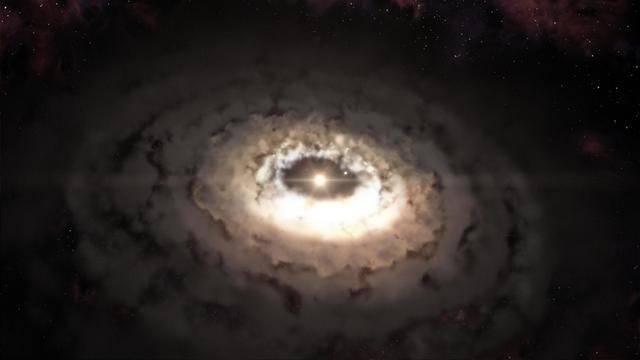Artist’s impression shows the dust trap in the system Oph-IRS 48. The dust trap provides a safe haven for the tiny rocks in the disc, allowing them to clump together and grow to sizes that allow them to survive on their own. (Credit: ESO/L. Calçada)
An international team of researchers using the new Atacama Large Millimeter/submillimeter Array (ALMA) telescope has discovered a "dust trap" that could help explain how rocky planets are able to evolve out of a swirling disk of dust and gas.
By imaging young solar system Oph IRS 48, approximately 390 light-years from Earth, astronomers have discovered evidence of the theoretical dust trap.
"There is a major hurdle in the long chain of events that leads from tiny dust grains to planet-sized objects," said Til Birnstiel, a researcher at the Harvard-Smithsonian Center for Astrophysics, and co-author on the paper published in the journal Science.
"In computer models of planet formation, dust grains must grow from submicron sizes to objects up to ten times the mass of the Earth in just a few million years. But once particles grow large enough, they begin to pick up speed and either collide, sending them back to square one, or slowly drift inward," toward their central star.
To get past this limit, astronomers theorized that swirling eddies in the disk could trap dust, eventually forming larger objects.
To create a dust trap, a very large gas-giant planet or companion star must pass through the disk, clearing a path around the star and producing the essential eddies and vortices in its wake.
Previous studies of Oph IRS 48 revealed a ring of carbon monoxide gas and small dust grains around the star, and showed a large gap in the disk, suggesting a very massive planet, on the order of 10 Jupiter masses, or a companion star was present.
Such an object could produce the necessary conditions for a dust trap. Using ALMA, researchers observed both the gas and the dust grains, revealing something other telescopes could not -- a lopsided bulge in the outer portion of the disk.
"Instead of the ring we had expected to see, we found a very clear cashew-nut shape," said Nienke van der Marel, a Ph.D. student at Leiden Observatory in the Netherlands and lead author on the paper.
The ALMA observations revealed only the outer structure of the disk, at more than 50 times the distance of the Earth to the Sun, though the principle would still be the same closer to the star where rocky planets would form.
"We may be seeing something analogous to the formation of our Sun's Kuiper Belt or Oort Cloud, the region of our solar system where comets are believed to originate," Birnstiel said.
ALMA's eventual full complement of 66 antennas will be in operation later this year, at which point it will have one of the sharpest visions of any observatory in the world.















